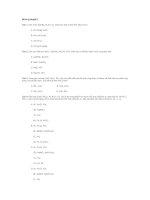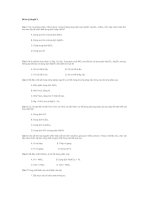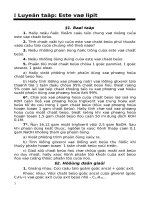Mkt308 ôn final(lý thuyết)
Bạn đang xem bản rút gọn của tài liệu. Xem và tải ngay bản đầy đủ của tài liệu tại đây (103.17 KB, 10 trang )
Chapter 1
1. The main types of digital marketing platform: Desktop, laptop, and notebook platforms/
Mobile phone and tablet platforms / Other hardware platforms (gaming platforms, indoor and
outdoor kiosk-type apps, interactive signage, wearables)
2. Digital marketing definitions: Achieving marketing objectives through applying digital
technologies and media
3. Paid, owned, and earned media definitions:
- Paid media: also know as bought media, a direct payment occurs to a site owner or an ad,
a sponsorship or pay for a click, lead or sale generated.
- Owned media: Different forms of online media controlled by a company including their
website, blogs, email list and social media presence.
- Earned media: The audiences is reached through editorial, comments and sharing online.
4. Benefits of digital marketing: identifying, anticipating, satisfying
- Identifying: the Internet can be used for marketing research to find out customers’ needs
and wants.
- Anticipating: the Internet provides an additional channel by which customers can access
information and make purchases – evaluating this demand is key to governing resource
allocation to e-marketing.
- Satisfying: a key success factor in e-marketing is achieving customer satisfaction through
the electronic channel, which raises issues such as: is the site easy to use, does it perform
adequately, what is the standard of associated customer service and how are physical
products dispatched.
5. The use of Internet in achieving strategic directions: market penetration, market
development, product development, diversification
- market penetration: the Internet can be used to sell more existing products into existing
market.
- market development: here the Internet is used to sell into new geographical markets,
taking advantage of the low cost of advertising internationally without the necessity for a
supporting sales infrastructure in the customers’ countries.
- product development: New products or services are developed which can be delivered by
the Internet. These are typically digital products.
- diversification: In this sector, the Internet supports selling new products which are
developed and sold into new markets.
6. Business models defintions:
B2C: Business to customer definition: Commercial transactions between an organization
and consumers.
B2B definition (Business to business): Commercial transactions between an organization
and otherorganisations (inter-organisational marketing)
C2C: consumer to consumer: Informational or financial transactions between consumers,
but usually mediated through a business site.
G2C: government to consumer: concept is used for expressing the relationship between
public administration and citizens. ( />C2B: consumer to business: Consumers approach the business with an offer.
C2G: consumer to government: feedback to government through pressure group or
individual sites.
B2G: business to government: feedback to government businesses and non-governmental
organisations.
G2G: government to government: Inter-government services and exchange of information.
7. The difference between e-commerce and e-business
Electronic commerce (e-commerce) refers to both financial and informational, ectmnicauy
electronically mediated transactions between an organisation and any third party It deals
with (Chaffey, 2014). So ecommerce involves management not only of online sales
transactions, but also of non-financial transactions such as inbound customer service
enquiries broadcasts, so you can argue that e-commerce is open to all online organisations.
E-commerce lS often further subdivided into a sell-Side e-commerce perspective, which
refers to transactions involved with selling products to an organisation's customers, and a
buy-side e-commerce perspective, which refers to business-to-business transactions to
procure resources needed by an organisation from its suppliers
Social commerce is an increasngly important part of e—commerce for Site owners, Since
incorporating reviews and ratings into a Site and linking to social networking sites can. Its
help understand customers’ needs and increase Conversion to sale. It can also involve
group he buying using a coupon service like Groupon. There is much discussion on the
extent to is a which social media interactions between consumers directly influence sales.
E-business or digital business is Similar to e-comnerce but broader in Scopf: and refers to
using digital technology to manage a range of busmess processes incorporating the sellside and buy-side e-commerce shown in Figure 1.7, and also other key supporting business
processes including research and development, marketing, manufacturing and inbound and
outbound logistics.
8. Six digital channels:
- Search engine marketing: search engine optimization (SEO), Paid search pay-per-click
(PPC), Paid for inclusion feeds.
- Online PR: Publisher outreach, Community participation, Media alerting, Brand protection.
- Online Partnership: Affiliate marketing, Sponsorship, Co-branding, Link-building.
- Display advertising: use of graphical or rich media ad units within a web page to achieve
goals of delivering brand awareness, familiarity, favourability and purchase. Many ads
encourage interaction through prompting the viewer to rollover to play videos, complete an
online form or to view more details before clicking through to a site.
- Opt-in email marketing: House list e-mails, Cold (rented list), Co-branded, Ads in third party
e-newsletter.
- Social media marketing: Audience participation, Managing social presence, Viral
campaigns, Customer feedback.
9. Benefits of digital media:
- interactivity
+ the customer initianformation or an experiece (pull)
+ it is a high-intensity medium-the maketer will have 100% of the individual's attention when
he or she is viewing tes contact
+ the customer is seeking ia website
+ a company can gather and store the response of the individual
+ individual needs of the custoemr can be addressed taken into account in the future
dialogues.
- intelligence: Digital media and technology can be used as a relatively low-cost method of
collecting marketing research, particularly about customer perceptions of products and
service.
- individualization: Based on intelligence collected about site visitors and then stored in a
database and subsequently used to target and personalise communications to customers to
achieve relevance in all media. The process of tailoring is also referred to as
personalisation.
- integration: When assessing the marketing effectiveness of a website, the role of the
Internet in communicating with customers and other partners can best be considered from 2
perspectives: outbond Internet-based communication from organization on customer and
Internet-based communication from customer to organization. Many companies have now
integrated email response and website callback into their existing call center or customer
service operation.
- industry restructuring: Disintermediation and reintermediation are key concepts of industry
restructuring that should be considered by any company developing an e-marketing
strategy.
- independence of location: Electronic media also introduce the possibility of increasing the
reach of company communications to the global market. This gives opportunities to sell into
international markets which may not previously have been possible
10. Key challenges of digital communications:
- Complexity: To enable the benefits we have mentioned above – such as personalization,
testing and dynamic variation in ads though time – time has to go into configuring the
campaign although the search engines provide defaults to enable easy setup. This requires
specialist expertise either in-house or at an agency to manage the campaign.
- Responding to competitors: Since competitors can also change their approach readily,
more resource has to be used to monitor competitor activity. Automated tools known as bid
management tools can assist with this – they will automatically check amounts competitors
are paying and then adjust them according to per-defined rules
- Responding to changes to technology and marketing platforms: Google and the other adserving companies innovate to offer better capabilities for their customers. This means that
staff managing campaigns needs training to keep up-to-date. Google offers ‘Adwords
Qualified Professionals’ so that companies can be certain of a minimum skills level.
- Cost: Although costs can be readily controlled, in competitive categories the costs can be
high, exceeding 10 bảng/click (tìm k thấy kí hiệu bảng anh =)))))
- Attention: While online paid search ads are highly targeted and there is arguably little
wastage, not everyone will view paid adverts, indeed there is a phenomenon known as
‘banner blindness’ where web users ignore online ads.
Chapter 2
1. Factors should be covered in situation analysis (pg.56)
- customers: Digital propositition and communications should be based around the
customer: their charactertistics, behaviours, needs, wants.
- market place analysis including intermediaries, influencers and potential partners: We will
see the there is a wide range of influences including search engines, publisher media sites,
blogs, review sites and social networks which should all be considered. Marketplace
analysis also involves reviewing opportunities and threats from digital media and technology.
- competitors: Benchmarking customer propositions and communications activities against
competitors can identify opportunities for nes approaches and digital marketing activities that
need to be improved.
- wider macro-environment: There are the broader strategic including social, legal,
environment, political, technology influences.
2. Micro environment, macro environment definitions
- Micro environment: The players (stakeholders) and their interactions which influence how
an organization responds in its marketplace.
- macro environment: Broad forces affecting all organizations in the marketplace, including
social, technological, economic, political, legal and ecological influences
3. Main elements of online marketplace map: (pg.63)
- customer segment: Marketplace analysis helps identify and summarise different target
segment for an online business in order to understand their online media consumption,
behaviour and the type of content and experiences they wants. Ina digital campaign,
personas are used to understand the preferences, chatacteristics and online behaviours of
different groups.
- search intermediaries: there are the main search engines in each country: Google, Yahoo!,
Bing,... There are companies which provide specialist audience dato to enable a digital
marketer to discover the relative importance of particular search engines.
- intermediaries, influencers and media publisher sites: Media sites and other intermediaries
are often sucessful in attracting visitors via customer search or direct to their websites if they
are mainstream brands. Companies need to assess potential online media and distribution
partners.
- destination sites and platforms: There are the sites that the marketer is trying to attract
visitors to, including transactional sites by retail, financial service, travel, manufacturers and
other companies or non-transactional sites.
4. the main types of online revenue models (pg.103)
- CPM (cost per thousand) display advertising on site: This is traditional method by which
site owners charge a fee for advertising. Ads may be served by the site owner's own ad
server or more commonly through a third-party ad network service.
- CPC (cost per click) advertising on site: Advertisers are charge to the number of times they
are clicked upon.Typical costs per click can be surprisingly high for some categories.
- sponsorship of site sections or content types: A company can pay to advertise a site
channel or section. This type of deal is often struck for a fixed amount per year. It may also
be part of a reciprocal arrangement, sometimes known as a contra-deal where neither party
pays.
- affiliate revenue: is commission-based. Increasingly, this approach is replacing CPM or
CPC approaches where the advertiser has more negotiating power.
- transaction fee revenue: A company receives a fee for facilitating a transaction.Examples
include eBay and PayPal, which charge a percentage of the transaction cost between buyer
and seller.
- subscription access to content or services: A range of documents can be accessed from a
publisher for a fixed period. These are often referred to as premium services on website.
- pay-per-view access to document: Here payment occurs for single access to a document,
video wwhich can be downloaded. It may or may not be protected with a password or digital
rights management.
- subscriber data access for email marketing: The data a site owner has about its customers
are also potentially valuable since it can send different forms of email to its customers if they
have given their permission to receive email from either the publisher or third parties. The
site owner can charge for adverts placed in its newsletter or can deliver a separate message
in behalf of advertiser.
5. Revenue model definition: Describe methods of generating income for an organization.
6. CPM definition (cost per thousand): The cost to the advertiser (or the revenue received by
the publisher) when an ad is served 1000 times.
7. CPC definition (cost per click): The cost to the advertised (or the revenue received by the
publisher) of each click of a link to a third- party site.
8. CPA definition (cost per acquisition): The cost to the advertiser (or the revenue received
by the publisher) for each outcome such as a lead or sale generated after a click to a thirdparty site.
Chapter 3
1. Internet definition: The physical network that links computers across the globe. It consists
of the infrastructure of network servers and communication links between them that are used
to hold and transport the vast amount of information.
2. World wide web definition: a medium for publishing information and providing service on
the Internet. It is accessed through web browsers, which display site content on different
web pages. The content making up websites is stored in the web servers.
3. Web browser definition: Used to store the web pages accessed by Web browsers. They
may also contain database of customer or product information, which can be queried are
retrieved using browser.
4. intranet definition: A network within a single company that enables access to company
information using the familiar tools of the Internet such as email and web browsers. Only
staff within the company can access the intranet, which will be password- protected.
5. extranet definition: Formed by extending the intranet beyond a company to customers,
suppliers, collaborators or even competitors. This is again password- protected to prevent
access by general Internet users.
6. SMS definition: The formal name for text messaging
7. Firewall definition: A specialized software application mounted on a server at the point
where the company is connected to the Internet . Its purpose is to prevent unauthorized
access into the company from outsides.
8. Mobile apps definition: A software application that is designed for use on a mobile phone,
typically downloaded from an App store. iPhone apps are best known, but all smartphones
support the used of apps which can provided user of apps with information, entertainment or
location- based services such as mapping.
9. QR code definition: quick response code- a two- dimensional matrix bar code. QR codes
were invented in Japan where they are a popular type of two- dimensional code used for
direct response.
10. Wifi definition : A high- speed wireless local- area network enabling wireless access to
the Internet for mobile, office and home users.
Chapter 5
1. Options for offering digital products
- subscription: This is a traditional pubisher revenue model, but subscription can potentially
be offered for different periods at different price points, e.g. three months, twelve months or
two years.
- pay-per-view: A free for a single download or viewing session at a higher relative price than
the subcription service.
- bundling: Different channels or content can be offered as individual products or grouped at
a reduced price compared to pay-per-view.
- ad-supported content: There is no direct price set here. Instead, the publisher’s main
revenue source is through adverts on the site (CPM display advertising on-stite using banner
ads and skyscrapes) a fixed sponsorship arrangement or CPC, which stands for “cost-perclick” – more typical when using search ad network publishing such as google adsense,
which accounts for around a third of google’s revenue. Other options include affiliate
revenue from sales on third-party sites or offering access to subscriber lists.
2. Options for performing new product development research online:
- online focus group: a moderated focus group can be conducted to compare
customers’experience of product use. Many companies now have permanet customer
panels they can use to ask about new ideas.
- online questionaire survey: There typically focus on the site visitors’ experience, but can
also include questions relating to products.
- customer feedback or support forums: Comments posted to the site or independent sites
such as social networks may give suggestions about future product innovation. Freshdesk
has developed a platform to enable a company to communicate and collaborate inside and
outside the company. The platform also has the capacity to intergrate with CRM, ecommerce and analytics systerms. Companies using freshdesk include Honda, 3M, Hugo
Boss, Kuoni and Unicef.
- web analytics: a wealth of marketing research information is also available from response
data from email and search campaigns and the website itself, since everytime a user clicks
on a link offering a particular product, this indicates a preference for products and related
offers. Such information can be used indirectly to assess customer’s product preferences.
3. Avatar definition: a term used in computer-mediated enviroments to mean a “virtual
person”. Derived from the word’ orginal meaning: the descendant of a Hindudeity in a visible
form; incarnation; supreme glorification of any principle. Avatar are increasingly being used
to reduce the need for enquires. Using of an avatar-based sales agent can lead to more
satisfaction with the retailer, a more positive attitude towards the product and a greater
purchase intent. They investigated the usage of “attractive” versus “expert” advisers
dependent on the complexity of the purchase decision.
Chapter 6
1. E-CRM definition: Using digital communications technologies to maximise sales to
existing customers and encourage contined usage of online services through techniques
including database, personalised web messages, personalised web messages, customer
services, email and social media marketing. E-CRM involves creating strategis and plans for
how digital technology and digital data can support CRM.
2. web self-service definition: Customers perform information requests and transactions
through a web interface rather than by contact with customer support staff.
3. Main types of customer data held as tables in customer databases for CRM:
- Personal and profile data: These include contact details and characteristics for profiling
customers, such as age and sex (B2C), and business size, industry sector and the
individual’ s role in the buying decision (B2B).
- Transaction data: a record of each purchase trasaction including specific product
purchased, quantities, category, location, date and time and channel where purchased.
- communication data: a record of which customers have been targeted by campaigns and
their response to them (outbound communications). Also includes a record of inbound
enquiries and sales representative visits and reports (B2B).
4. Permission marketing definition: is a significant concept that underpins online CRM in
management of the customer lifecycle. “Permission marketing” is a term coined by Seth
Godin 1999. Customers agree (opt-in) to be involved in an organisation’s marketing
activities, usually as a result of an incentive.
5. Interruption marketing: Marketing communications that disrupt customers’ activities
6. opt-in defitnion: a customers proactively agrees to receive futher information
7. opt-out definition: a customers declines the offer to receive futher information.
8. Customer profiling definition: Using the website to find out a customer’s specific interests
and characteristic.
9. Online voice of customer definition: Qualitative assessments of the effective of digital
presence based on direct customer feedback. They answer “who and why” questions about
how customers interact with brands online. Online VoC measures are useful for reviewing
customer sentiment online. The satisfaction rating we have reviewed are one example of
VoC measures. This is a key technique for improving online customer journeys.
Chapter 8
1. Push media definition: Communications are broadcast from an advertiser to consumers of
the message, who are passive recipients.
2. Pull media definition: The consumer is proactive in actively seeking out a solution and
interactions with brands and are attracted through content search and social media
marketing.
3. Four elements of the model that can constrain the effectiveness of Internet marketing:
- encoding: the design or development of the site content
- noise: the external influence that affects the quality of mess
- decoding: the process of interpreting mess
- feedback: occurs through online forms and through monitoring of on-site behavior through
web analytics
4. Unique visitor definition: Individual visitor to a site measured through cookies or the IP
address on an individual computer.
5. Five main types of goals of an interactive marketing communications:
- audience or traffice goals: target for using online site promotion and offline site promotion
to drive quality visitors
- conversion or interation(xấp xỉ) goals: use onsite communications to deliver an effective
mess
- third-party site reach and branding goals: influence and engage with prospective (bảo hộ)
customers on third-party sites (exp: reach a targeted audience of 500,000 during the
campaign)
- multichannel marketing goals: Integrate (hợp thành 1 thể thống nhất) all communications
methods to help achieve marketing objectives by supporting mixed-mode buying.
- longer brand engagement goals: measured through lifetime value, loyalty and customer
interactions
6. Media site definitions: Typical location where paid- for ads are placed.
7. Call-back service definition: A facility available on the website for a company to contact a
customer at a later time as specified by the customer.
Chapter 7
1.
Soft launch definition: a trial version of a site launched with limited publicity.
Chaper 9
1. SEO definition: a structured approach used to increase the position of a company or its
products in search engine natural or organic results listings for selected keywords or
phrases.
2. SEM definition: promotion an organization through search engines to meet its objectives
by delivering relevant content in the search listings for searchers and encouraging them to
click through to a destination site.
2 key techniques:
-search engine optimization (SEO): to improve results from the natural listings
-paid-search marketing: to deliver results from the sponsored listings within the search
engines.
8. Display advertising definition: display ad are paid ad placements using graphical or rich
media ad units within a web page to achieve goals of delivering brand awareness, familiarity,
favorability and purchase intent. Many ads encourage interaction through prompting the
viewer to interact or rollover to play videos, complete an online form or to view more details
by clicking through to a site.
9. outbound email marketing definition: email are sent to customers and prospects from an
organization.
10. inbound email marketing definition: management of emails from customers by an
organization.
Chapter 10
1. Channel promotion definition: measures that assess why customers visit a site – which
adverts they have seen, which sites have they been reffered from.
2. Channel buyer behaviour definition: Describes which content is visited and the time and
duration.
3. Conversion rate definition: percentage of site visitors who perform a particular action such
as making a purchase.
4. Pages per visit definition: (PPV) the average number of pages viewed per visitor to a site
(this is indicative of engagement with a site since the longer visitor stays on a “sticky site”,
the higher this value will be). PPV is a more accurate indication of stickiness than duration
on a site in minutes since this figure is skewed upwards by visitors who arrive on a site and
are inactive before their session tims out at 30 minutes.
5. visits per visitor definition: (VPV) this suggests the frequency of site visits. Readers will
realize that this value is dependent on the period that data are collected over.
(đọc hiểu)
Chapter 9
3. Advantages of SEO:
- significant traffice driver: search marketing can attract a significant proportion f visitors to
the site if companies are successful in implementing it.
- highly targeted: visitors are searching for particular products or services so will often have a
high intent to purchase – they are qualified visitors.
- potentially low-cost visitors: there are no media costs for ad display or click-through. Costs
arise solely from the optimization process where agencies are paid to improve positions in
the search results.
- Dynamic: the search engine robots will crawl the home page of popular sites daily, so ne
content is included relatively quickly for the most popular pages of a site (less for deep links)
4. Disadvantages of SEO:
- lack of predictability: compared with other media SEO is very unreliable in term of the
return on investment – it is difficult to predict results for a given investment and is highly
competitive.
- time for results to be implemented: the reults from SEO may tale months to be achieved,
especially for new sites.
- complexity and dynamic nature: the search engines take hundreds of factors into account,
yet the relative weighting are not published, so there is not a direct correlation between mkt
actions and results
- ongoing investment: investment needed to continue to develop new content and generate
new links.
- poor for developing awareness in comparison with other media channels: searchers
already have to be familiar with a brand or service to fine it. However, it offers the
opportunity for less well-known brands to “punch above their weight” and to develop
awareness following click-through.
5. advantages of paid search marketing:
- the advertisier is not paying for the ad to be displayed
- PPC advertising is highly targeted
- Good accountability: with the right tracking system, the ROI for individual keywords can be
calculated
- predictable: traffic, rankings and results are generally stable and predictable in comparison
with SEO
- technically simpler than SEO: position is based on combination of bid amount and quality
score.
- remarketing: google offers retargeting through cookies placed on the searcher computer to
display ads on the content network after someone has clicked on a paid search ad or visited
a specific page on a site as a reminder to act. these can be effective in boosting the
conversion rate to lead or sale.
- speed: PPC listing get posted quickly, usually in a few days (following editor review). SEO
results can take weeks or months to be achieved. Moreover, when a website is revised for
SEO, ranking will initially drop while the site is re-indexed by the search engines.
- Branding: tests have shown that there is a branding effect with PPC, even if users do not
click on the ad. This can be useful for the launch of products or major campaign.
6. Disadvantages of paid search marketing
- competitive and expensive: since pay-per-clicks has become popular, some companies
may get involved in bidding wars that drive bids up to an unacceptable level.
- inappropriate: for companies with a lower budget or a narrower range of products on which
to generate lifetime value, it might not be cost-effective to compete.
- requires specialist knowledge: PPC requires a knowledge of configuration, budding options
and of the reporting facilities of different ad networks. Internal staff can be trained, but they
will need to keep up-to-date with changes to paid search services.
- time-consuming: to manage a PPC account can require daily or even hourly checks on the
bidding in order to stay competitive. This can amount to a lot of time. The tools and best
practice varies frequently so keeping up-to-date is difficult.
- irrelevant: sponsored listings are only part of the search engine mkt mix. Many search
users do not click on these because they don’t trust advertisers, although these are mainly
people involve mkt.
7. advantages of online public relations
- Reach: . E-PR can be a relatively low-cost method of directly reaching a niche audience or
a mass audience if the brand is amenable to stories that are of interest to publishers. This is
often the case for new online brands and startups such as Zopa (www.zopa.com). If buzz
around an online campaign orchestrated through online PR is successful then additional
reach and impact may also be generated by traditional media such as TV print and radio.
- Cost: The costs for online PR are the agency or internal staff fees for developing the online
PR plan, concepts and content. Since there are no media placement costs, this can be costeffective.
- Credibility: Comments that are made by a person independent from a company are
considered are authentic and so can help raise trust about an online provider such as a
retailer. You can see that personal recommendations are particularly important and seem to
be trusted more than content sites giving reviews and opinions (although these still given
credence by many web users)
- Search engine optimization: E-PR can help generate backlinks to a site which are
favourable for SEO, often from large site sites such as online newspapers or magazines
which have good link equity.
- brand-enhancement and protection: Favourable stories can enhance the reputation of a
bran among its target audience and amplification through influencers can help reach a new
audience. But since unfavourable media mentions may damage a brand, so monitoring and
response to these is a necessity for most brands.
Chapter 10
6. Factors of selecting a web analytics tools:
- integration with other data sources (for example, social media marketing, customer data
and financial reporting).
- accuracy:
- media attribution
- visualisation: how data are displayed through reports and alerts. Vendors continually
introduce new features in this area.
- customisation facilities: for creating and distributing new reports and alerts.
- support services
- privacy consideration
7. Five classes of online feedback tools:
- website feedback tools: provide a permanent facility for customers to give feedback by
prompts on every page.
- site user intent-satisfaction surveys: measure the gap between what the user had hoped to
do on the site and what they actually achieved.
- crowdsourcing product opinion software: broader than web feedback, enabling customers
to comment about potential new services.
- simple page or concept feedback tools: again a form off crowdsourcing, give feedback from
an online panel about page layout, messaging or services.
- general online survey tools: enable companies to survey their audience at a low cost (for
example: zoomerang, survey monkey,…)









